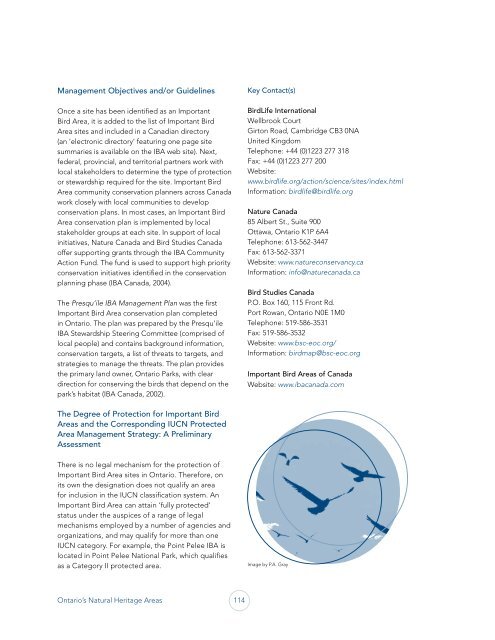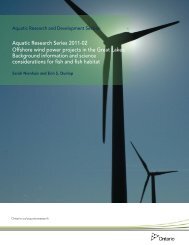Ontario's Natural Heritage Areas - Ministry of Natural Resources
Ontario's Natural Heritage Areas - Ministry of Natural Resources
Ontario's Natural Heritage Areas - Ministry of Natural Resources
Create successful ePaper yourself
Turn your PDF publications into a flip-book with our unique Google optimized e-Paper software.
Management Objectives and/or Guidelines<br />
Once a site has been identified as an Important<br />
Bird Area, it is added to the list <strong>of</strong> Important Bird<br />
Area sites and included in a Canadian directory<br />
(an ‘electronic directory’ featuring one page site<br />
summaries is available on the IBA web site). Next,<br />
federal, provincial, and territorial partners work with<br />
local stakeholders to determine the type <strong>of</strong> protection<br />
or stewardship required for the site. Important Bird<br />
Area community conservation planners across Canada<br />
work closely with local communities to develop<br />
conservation plans. In most cases, an Important Bird<br />
Area conservation plan is implemented by local<br />
stakeholder groups at each site. In support <strong>of</strong> local<br />
initiatives, Nature Canada and Bird Studies Canada<br />
<strong>of</strong>fer supporting grants through the IBA Community<br />
Action Fund. The fund is used to support high priority<br />
conservation initiatives identified in the conservation<br />
planning phase (IBA Canada, 2004).<br />
The Presqu’ile IBA Management Plan was the first<br />
Important Bird Area conservation plan completed<br />
in Ontario. The plan was prepared by the Presqu’ile<br />
IBA Stewardship Steering Committee (comprised <strong>of</strong><br />
local people) and contains background information,<br />
conservation targets, a list <strong>of</strong> threats to targets, and<br />
strategies to manage the threats. The plan provides<br />
the primary land owner, Ontario Parks, with clear<br />
direction for conserving the birds that depend on the<br />
park’s habitat (IBA Canada, 2002).<br />
The Degree <strong>of</strong> Protection for Important Bird<br />
<strong>Areas</strong> and the Corresponding IUCN Protected<br />
Area Management Strategy: A Preliminary<br />
Assessment<br />
There is no legal mechanism for the protection <strong>of</strong><br />
Important Bird Area sites in Ontario. Therefore, on<br />
its own the designation does not qualify an area<br />
for inclusion in the IUCN classification system. An<br />
Important Bird Area can attain ‘fully protected’<br />
status under the auspices <strong>of</strong> a range <strong>of</strong> legal<br />
mechanisms employed by a number <strong>of</strong> agencies and<br />
organizations, and may qualify for more than one<br />
IUCN category. For example, the Point Pelee IBA is<br />
located in Point Pelee National Park, which qualifies<br />
as a Category II protected area.<br />
Ontario’s <strong>Natural</strong> <strong>Heritage</strong> <strong>Areas</strong> 114<br />
Key Contact(s)<br />
BirdLife International<br />
Wellbrook Court<br />
Girton Road, Cambridge CB3 0NA<br />
United Kingdom<br />
Telephone: +44 (0)1223 277 318<br />
Fax: +44 (0)1223 277 200<br />
Website:<br />
www.birdlife.org/action/science/sites/index.html<br />
Information: birdlife@birdlife.org<br />
Nature Canada<br />
85 Albert St., Suite 900<br />
Ottawa, Ontario K1P 6A4<br />
Telephone: 613-562-3447<br />
Fax: 613-562-3371<br />
Website: www.natureconservancy.ca<br />
Information: info@naturecanada.ca<br />
Bird Studies Canada<br />
P.O. Box 160, 115 Front Rd.<br />
Port Rowan, Ontario N0E 1M0<br />
Telephone: 519-586-3531<br />
Fax: 519-586-3532<br />
Website: www.bsc-eoc.org/<br />
Information: birdmap@bsc-eoc.org<br />
Important Bird <strong>Areas</strong> <strong>of</strong> Canada<br />
Website: www.ibacanada.com<br />
Image by P.A. Gray

















